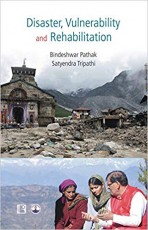Om Publications

Disaster, Vulnerability and Rehabilitation: A Study of Uttarakhand
Bindeshwar Pathak and Satyendra Tripathi
₹808 ₹950 (15% off)
ISBN 13
9788131609880
Year
2019
Contents: 1. Introduction. 2. Theoretical Perspective of Natural Disasters. 3. Vulnerability and Risk Analysis in Uttarakhand. 4. Profile of Area. 5. Rationale, Objectives and Research Methodology. 6. Natural Disasters and Widowhood. 7. Sulabh Movement and Social Transformation. 8. Conclusion and Suggestions.
India is one of the world’s major theatres of disasters, both natural and human-induced. India’s geo-climatic conditions as well as its high degree of socio-economic vulnerability make it one of the most disaster prone countries in the world. Over last three decades, the country has witnessed 431 major disasters resulting in enormous loss of life and property. The country is highly vulnerable to floods, droughts, cyclones, earthquakes, landslides, avalanches and forest fires.
The newly created state of Uttarakhand has a large chunk of geographical area under the Himalayan ecosystem which is prone to earthquakes, flash floods, landslides, forest fires and road accidents. The flash flood which was followed by land sliding in June 2013, devastated the whole economy of the state. The study calls for imperative need of sustainable and socially responsible development in the context of rampant urbanization, deforestation, unregulated tourism activities, construction of hydropower projects and growing demand of scant resources. Policymakers need to address these crucial issues for prevention and mitigation of natural disasters in the state.
The study highlights theoretical perspectives on disasters, its prevention and mitigation along with assessment of vulnerability and risks in the context of Uttarakhand state. It further highlights the contribution of Sulabh International Social Service Organisation in rehabilitation and reconstruction of disaster affected areas in Dewali village panchayat in Rudraprayag district. It also provides in-depth analysis of profile and rehabilitation of widows of this natural calamity of 2013.
It is expected that the book will be highly useful in understanding the dynamics of development and natural disasters. It demonstrates the imperative need of sustainable development in keeping the right balance among the three pillars of ecology, environment and development.